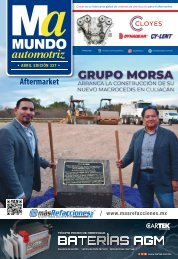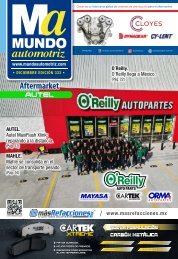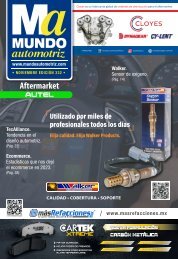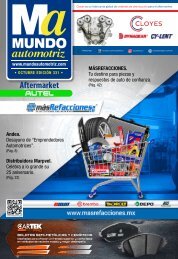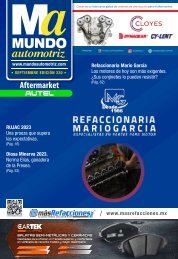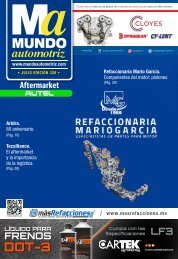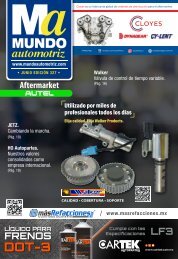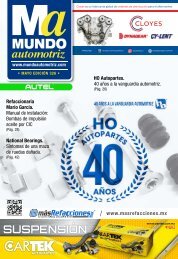Mundo Automotriz La Revista No. 241 Abril 2016
Los especialistas en Aftermarket
Los especialistas en Aftermarket
- No tags were found...
Create successful ePaper yourself
Turn your PDF publications into a flip-book with our unique Google optimized e-Paper software.
ARTÍCULO TÉCNICO<br />
FILTRO DE GASOLINA<br />
En realidad, el filtrado del combustible que se suministra al<br />
motor, es responsabilidad de un conjunto de filtros que, se<br />
encargan de evitar que elementos indeseados ingresen a la<br />
cámara de combustión, así como mantener el sistema de<br />
combustible limpio para extender la vida útil de los componentes<br />
involucrados.<br />
Cedazo de la bomba de gasolina. Es el primer elemento<br />
que filtra el combustible, evitando que la suciedad del<br />
tanque ingrese al ducto de succión de la bomba, se localiza<br />
junto a la bomba de combustible dentro del tanque y se<br />
reemplaza junto con la bomba o en cada limpieza de tanque<br />
de combustible.<br />
Filtro de gasolina. Este elemento se procura reemplazar en<br />
cada servicio mayor, programado normalmente a los 40,000<br />
Km. (25,000 Millas) cuando el sistema se encuentra trabajando<br />
normalmente.<br />
Micro-filtros. Dichos componentes, conocidos así por su<br />
tamaño, los encontraremos como parte de los inyectores<br />
de combustible y son los últimos elementos de filtración del<br />
combustible, se recomienda el reemplazo de estos componentes<br />
en cada servicio profesional que busca devolver las<br />
condiciones óptimas del sistema de Inyección en promedio<br />
cada 80,000 Km. (50,000 Millas) aunque en los talleres de<br />
servicio en las agencias, recomiendan reemplazar los inyectores<br />
completos y no sólo los micro-filtros.<br />
Recomendaciones para filtro de gasolina:<br />
a) Nunca suministre combustible a su vehículo<br />
que no provenga de una bomba autorizada.<br />
b) Los aditivos de limpieza se recomiendan como<br />
un método preventivo de fallas, mas nunca<br />
debe utilizarlos como método correctivo.<br />
FILTRO DE CABINA<br />
Este filtro se encarga de limpiar el polvo, hollín, polen y<br />
esporas del aire que entra al vehículo a través del ducto de<br />
ventilación cuando utilizamos el aire acondicionado, el calefactor<br />
o el desempañador. <strong>No</strong>rmalmente lo encontraremos<br />
dentro de la cabina, debajo del tablero ya sea de lado del<br />
conductor o detrás del tablero frente al copiloto.<br />
Este filtro se recomienda reemplazar cada que los ocupantes<br />
del vehículo perciban malos olores dentro de la cabina, y<br />
lo podrá reemplazar fácilmente siguiendo las recomendaciones<br />
que se encuentran en el manual de usuario del<br />
vehículo.<br />
GASOLINE FILTER<br />
Actually, filtering the fuel supplied to the engine is the<br />
responsibility of a set of filters that prevent unwanted<br />
elements from entering the combustion chamber and<br />
keep the fuel system clean to extend the life of the involved<br />
components:<br />
Fuel pump’s strainer. It’s the first element that filters fuel,<br />
preventing dirt from the tank to enter the pump’s suction<br />
duct. It’s located next to the fuel pump inside the tank and<br />
must be replaced with the pump or every fuel tank cleaning.<br />
Gasoline filter. This element has to be replaced on every<br />
major service, normally scheduled at 40,000 km. (25,000<br />
miles), when the system is working normally.<br />
Micro-filters. These components, named by their size,<br />
can be found as part of the fuel injectors and are the last<br />
elements of fuel filtration, it is recommended to replace<br />
these components on every professional service that aims<br />
to restore the optimum conditions of the injection system<br />
every 80,000 km. (50,000 miles) in average, although<br />
service workshops at car dealers recommend replacing the<br />
whole injectors and not just de micro-filters.<br />
Gasoline filter recommendations:<br />
a) Never put fuel in your vehicle that does not come from a<br />
certified pump.<br />
b) Cleaning additives are recommended as a preventive<br />
measure for failures, but they should never be used as a<br />
corrective measure.<br />
CABIN FILTER<br />
This filter is responsible for cleaning dust, soot, pollen and<br />
spores in the air entering the vehicle through the ventilation<br />
duct when using the air conditioner, heater or defroster.<br />
<strong>No</strong>rmally it’s found in the cabin, under the dash, either<br />
on the driver’s side or behind the dashboard facing the<br />
passenger.<br />
It’s recommended to replace this filter when passengers<br />
detect foul odors inside the cabin, and can be replaced<br />
easily by following the recommendations found in the<br />
owner’s manual.<br />
62<br />
Síguenos en Facebook: <strong>Revista</strong> <strong>Mundo</strong> <strong>Automotriz</strong>







